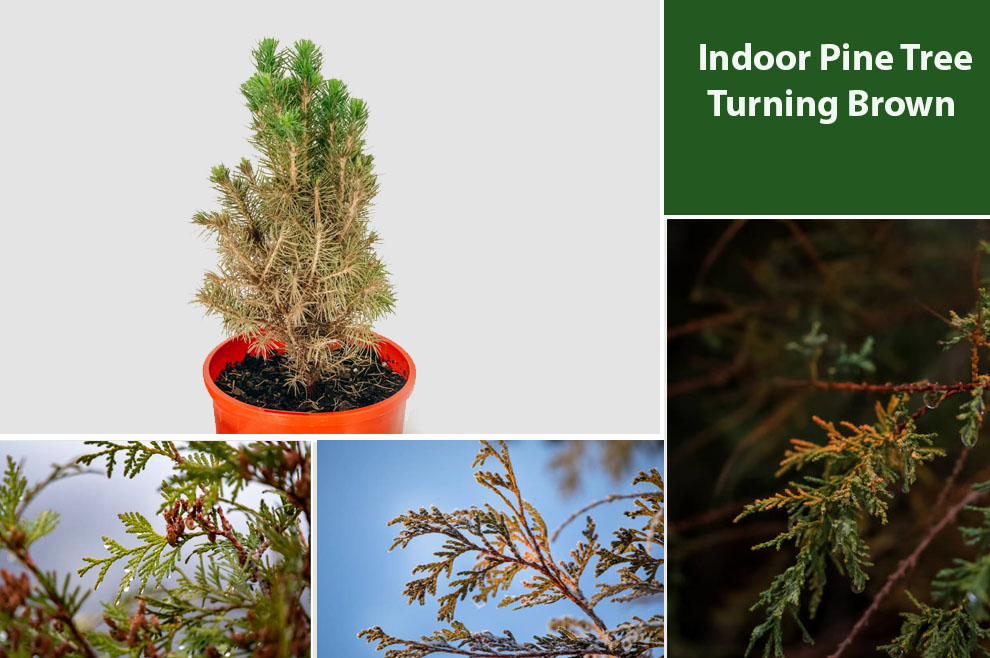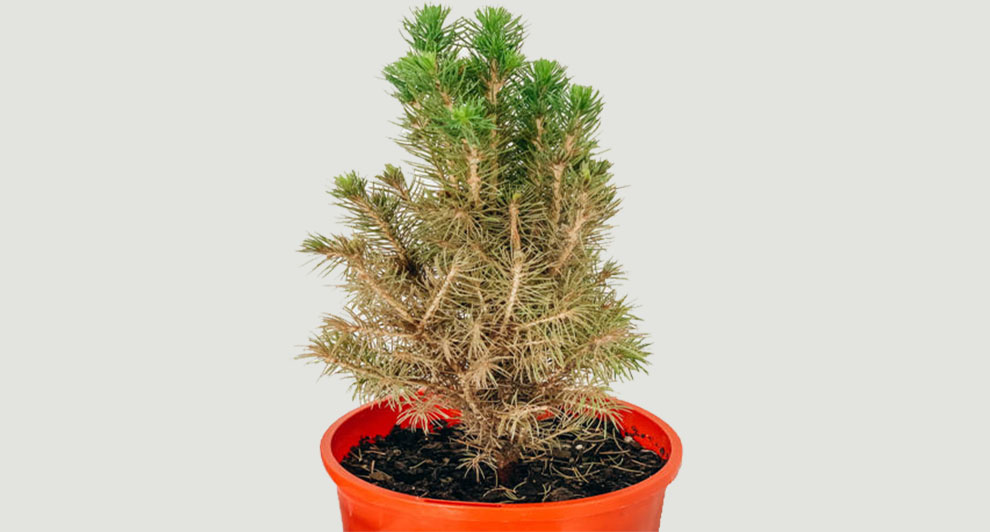How To Save An Indoor Pine Tree from Turning Brown & Dying?
To rescue an indoor pine tree from browning and dying, ensure it receives adequate sunlight, water it moderately, maintain proper humidity levels, avoid over-fertilization, and inspect for pests. Regular care and attention will help your pine tree thrive.

Indoor pine trees have a unique charm, adding to the aesthetics of our homes. However, if you’ve noticed your once-vibrant indoor pine tree now going brown, it’s time to take action.
This transformation can be alarming, but it’s a call for help from your evergreen companion.
In this article, we’ll delve into the causes behind indoor pine trees turning brown and explore effective solutions.
Whether you’re a seasoned indoor gardener or just starting your journey, understanding the underlying issues and addressing them promptly is vital.
Not only does it preserve the beauty of your indoor pine, but it also ensures the well-being of your cherished green companion.
From insufficient light to improper watering, we’ll uncover the culprits responsible for the browning needles and share practical steps to revive your pine’s health.
You’ll also discover the crucial role of soil conditions, the significance of pest control, and the impact of environmental factors on your indoor pine’s appearance.
Remember, early intervention is key to restoring your indoor pine tree’s lush greenery.
By the end of this article, you’ll not only have a deeper understanding of the problem but also the confidence to nurture and enjoy a thriving indoor pine tree, transforming your home into a haven of natural beauty once more.
Understanding Indoor Pine Trees
There are so many indoor pine tree varieties, with Eastern White Pine, Norfolk Island Pine, and Aleppo Pine among the most popular.
Each species brings its unique charm, from the delicate, feathery foliage of the Norfolk Island Pine to the classic, rugged appearance of the Eastern White Pine.
The allure of indoor pine trees lies in their evergreen beauty and the sense of tranquility they bring to interior spaces. They purify the air and provide a connection to nature.
However, challenges like proper care, maintaining moisture levels, and addressing potential browning can pose dilemmas for indoor gardeners.
Reasons For Indoor Pine Tree Dying After Turning Brown

There can be many reasons for indoor pine trees going brown and dying out. Some of the most common ones include:
A. Insufficient Light
Indoor pine trees need ample sunlight. Insufficient light leads to browning due to reduced photosynthesis. Ensure they receive bright, indirect sunlight or use grow lights to supplement.
B. Overwatering or Underwatering
Overzealous watering or neglecting moisture needs can result in browning. Overwatering suffocates roots, while underwatering causes stress and dehydration. Find the right balance by checking soil moisture regularly.
C. Poor Soil Conditions
Inadequate soil quality affects nutrient absorption and drainage. Use well-draining soil with good aeration to prevent waterlogged roots and nutrient deficiencies.
D. Pest Infestations
Pests like spider mites or scale insects can damage pine trees. Regularly inspect for pests and apply appropriate treatments if infestations occur.
E. Temperature and Humidity Issues
Pine trees thrive in cool, moderately humid conditions. Extreme temperature fluctuations and low humidity can lead to browning. Maintain stable environmental conditions.
F. Container Size and Root Bound Trees
If the container is too small or the tree becomes root-bound, it hinders root growth and nutrient uptake, resulting in browning. Repot when necessary to provide sufficient space for healthy root development.
Identifying The Problem At The Right Time
Identifying when an indoor pine tree is turning brown is crucial for timely intervention.
Signs of trouble include yellowing needles, indicating stress or nutrient deficiency. Browning tips can result from various factors, including inadequate watering or light.
Dropping needles, especially when it’s not the natural shedding season, signals distress. These signs collectively paint a picture of declining health, prompting the need for corrective measures to save your indoor pine tree.
How To Save A Dying Pine Tree Indoors?
Reviving and maintaining healthy indoor pine trees requires a comprehensive approach to address their specific needs. Here are the essential steps:
A. Adjusting Light Conditions: Assess your pine tree’s light exposure. Ensure it receives bright, indirect sunlight, mimicking its natural habitat. Inadequate light can lead to browning. Consider supplementary grow lights if necessary, especially during the darker winter months.
B. Proper Watering Techniques: Balance is key. Overwatering can suffocate roots, while underwatering causes stress. Water when the top inch of soil feels dry, and use a saucer to catch excess water. Ensure proper drainage to prevent root rot.
C. Soil Amendments and Repotting
Use well-draining, acidic soil rich in organic matter. Repot your pine tree every few years to refresh the soil and provide ample space for root growth. Repot during the spring to minimize stress.
D. Pest Control Measures
Regularly inspect your pine tree for pests like spider mites or scale insects. If you detect an infestation, use appropriate treatments or introduce natural predators. Neem oil or insecticidal soap can be effective while being gentle on the tree.
E. Temperature and Humidity Management: Maintain a cool, stable temperature range, ideally between 60-70°F (15-24°C). Pine trees appreciate higher humidity levels, especially during the winter when indoor heating can dry the air. Use a humidity tray or room humidifier to create an optimal environment.
How To Prevent Indoor Pine Trees From Browning?
Preventive measures are vital to ensure that you never witness an indoor pine tree dying. These tips help you keep them healthy and vibrant.
1. Light Management: Ensure your pine tree receives adequate, indirect sunlight. Rotate the pot periodically to ensure even light exposure.
2. Proper Watering Routine: Develop a consistent watering schedule based on the tree’s needs. Avoid overwatering or letting the soil dry out completely.
3. Humidity Control: Maintain higher humidity levels, especially during winter when indoor heating can dry the air. Use a humidity tray or room humidifier.
4. Appropriate Soil: Use well-draining, acidic soil suitable for pine trees. Regularly check the soil’s condition and repot when needed.
5. Regular Inspection: Periodically inspect your pine tree for signs of stress, pests, or disease. Early detection allows for timely intervention.
6. Pest Prevention: Keep the indoor environment clean and pest-free. Avoid introducing outdoor pests to your indoor pine.
7. Choose varieties suited for indoors: Selecting the right species that aligns with your indoor conditions and maintenance capabilities is crucial for preventing browning and ensuring your indoor pine thrives.
Some varieties that thrive indoors are Norfolk Island Pine Eastern White Pine, Mugo Pine, Japanese Black Pine, etc.
Pair this with diligent care and a proactive approach to maintain the health and beauty of your indoor pine trees.
Related Pine Tree Information: Pine Tree Lifespan | Pine Tree Growth Rate | Pruning Pine Trees | Best Pine Tree Fertilizer | Bonsai Pine Trees
What Does Indoor Pine Tree Turning Brown In The Fall Indicate?
An indoor pine tree browning in the fall often suggests a natural shedding of older needles, which is typical during this season.
However, it can also result from overwatering or inadequate light. Carefully assess watering and light conditions to ensure the tree’s health.
Is It A Problem If My Indoor Pine Tree Turns Brown In Summer?
Yes, an indoor pine tree going brown in summer can be a problem. In summer, indoor pine trees should generally maintain their vibrant green color.
Browning needles during this season may indicate issues like overwatering, inadequate humidity, or insufficient light. Promptly addressing these factors is crucial to maintain the tree’s health and appearance.
